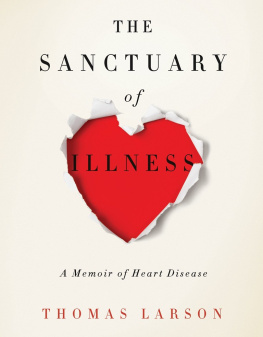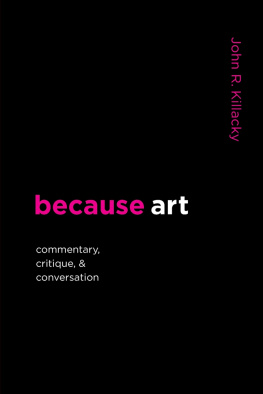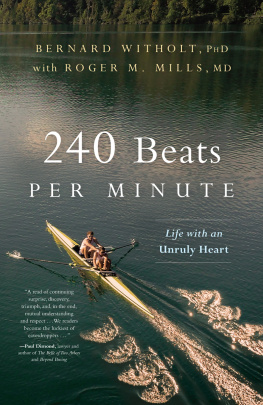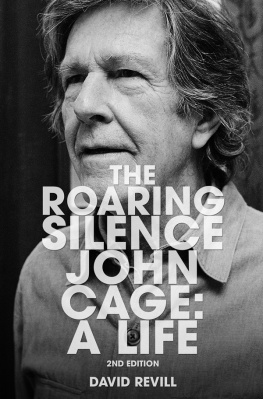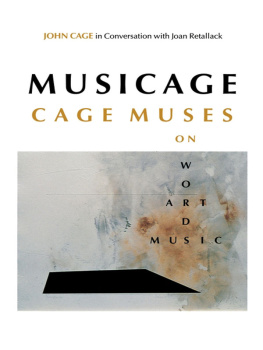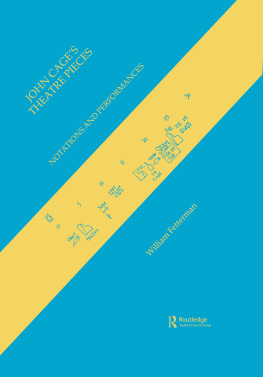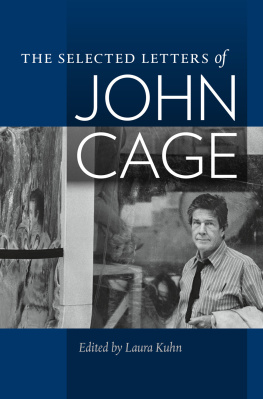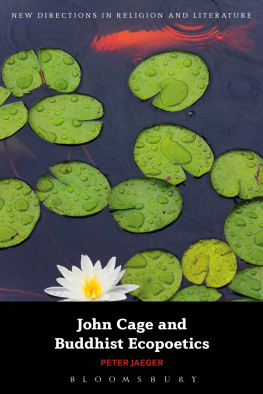Kay Larson - Where the Heart Beats: John Cage, Zen Buddhism, and the Inner Life of Artists
Here you can read online Kay Larson - Where the Heart Beats: John Cage, Zen Buddhism, and the Inner Life of Artists full text of the book (entire story) in english for free. Download pdf and epub, get meaning, cover and reviews about this ebook. year: 2012, publisher: Penguin Publishing Group, genre: Detective and thriller. Description of the work, (preface) as well as reviews are available. Best literature library LitArk.com created for fans of good reading and offers a wide selection of genres:
Romance novel
Science fiction
Adventure
Detective
Science
History
Home and family
Prose
Art
Politics
Computer
Non-fiction
Religion
Business
Children
Humor
Choose a favorite category and find really read worthwhile books. Enjoy immersion in the world of imagination, feel the emotions of the characters or learn something new for yourself, make an fascinating discovery.

- Book:Where the Heart Beats: John Cage, Zen Buddhism, and the Inner Life of Artists
- Author:
- Publisher:Penguin Publishing Group
- Genre:
- Year:2012
- Rating:5 / 5
- Favourites:Add to favourites
- Your mark:
- 100
- 1
- 2
- 3
- 4
- 5
Where the Heart Beats: John Cage, Zen Buddhism, and the Inner Life of Artists: summary, description and annotation
We offer to read an annotation, description, summary or preface (depends on what the author of the book "Where the Heart Beats: John Cage, Zen Buddhism, and the Inner Life of Artists" wrote himself). If you haven't found the necessary information about the book — write in the comments, we will try to find it.
Kay Larson: author's other books
Who wrote Where the Heart Beats: John Cage, Zen Buddhism, and the Inner Life of Artists? Find out the surname, the name of the author of the book and a list of all author's works by series.
Where the Heart Beats: John Cage, Zen Buddhism, and the Inner Life of Artists — read online for free the complete book (whole text) full work
Below is the text of the book, divided by pages. System saving the place of the last page read, allows you to conveniently read the book "Where the Heart Beats: John Cage, Zen Buddhism, and the Inner Life of Artists" online for free, without having to search again every time where you left off. Put a bookmark, and you can go to the page where you finished reading at any time.
Font size:
Interval:
Bookmark:
THE
HEART
BEATS
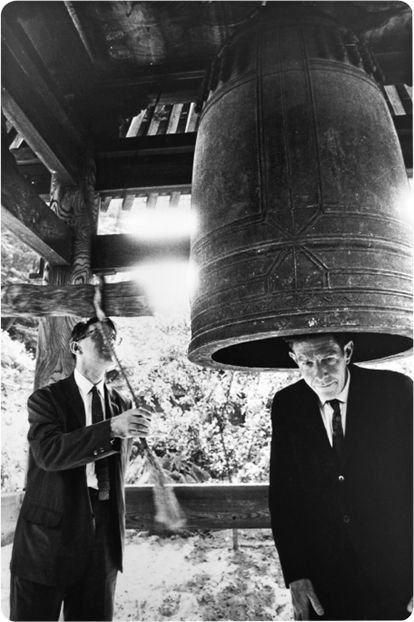
THE
HEART
BEATS
JOHN CAGE,
ZEN BUDDHISM,
AND THE INNER LIFE
OF ARTISTS
KAY LARSON
THE PENGUIN PRESS New York2012
THE PENGUIN PRESS
Published by the Penguin Group
Penguin Group (USA) Inc., 375 Hudson Street, New York, New York 10014, U.S.A. Penguin Group (Canada), 90 Eglinton Avenue East, Suite 700, Toronto, Ontario, Canada M4P 2Y3 (a division of Pearson Penguin Canada Inc.) Penguin Books Ltd, 80 Strand, London WC2R 0RL, England Penguin Ireland, 25 St Stephens Green, Dublin 2, Ireland (a division of Penguin Books Ltd) Penguin Books Australia Ltd, 250 Camberwell Road, Camberwell, Victoria 3124, Australia (a division of Pearson Australia Group Pty Ltd) Penguin Books India Pvt Ltd, 11 Community Centre, Panchsheel Park, New Delhi - 110 017, India Penguin Group (NZ), 67 Apollo Drive, Rosedale, Auckland 0632, New Zealand (a division of Pearson New Zealand Ltd) Penguin Books (South Africa) (Pty) Ltd, 24 Sturdee Avenue, Rosebank, Johannesburg 2196, South Africa
Penguin Books Ltd, Registered Offices: 80 Strand, London WC2R 0RL, England
First published in 2012 by The Penguin Press, a member of Penguin Group (USA) Inc.
Copyright Kay Larson, 2012
All rights reserved
Pages constitute an extension of this copyright page.
Library of Congress Cataloging-in-Publication Data
Larson, Kay.
Where the heart beats : John Cage, Zen Buddhism,
and the inner life of artists / Kay Larson.
p. cm.
Includes bibliographical references and index.
ISBN: 978-1-101-57248-1
1. Postmodernism. 2. Cage, JohnCriticism and interpretation. 3. Cage, JohnInfluence. 4. Zen BuddhismInfluence. I. Title.
NX456.5.P66L37 2012 2011044714
700.1dc23
Printed in the United States of America
1 3 5 7 9 10 8 6 4 2
DESIGNED BY NICOLE LAROCHE
No part of this book may be reproduced, scanned, or distributed in any printed or electronic form without permission. Please do not participate in or encourage piracy of copyrighted materials in violation of the authors rights. Purchase only authorized editions.
ALWAYS LEARNING
PEARSON
To John Daido Loori
Who sat silently until I was speechless
And set my feet on this path
To His Holiness the Dalai Lama
To His Holiness the Gyalwang Karmapa
And to all my teachers
To affect the quality of the day, that is the highest of the arts.
Henry David Thoreau
I cant understand why people are frightened of new ideas. Im frightened of the old ones.
John Cage
My intention has been, often, to say what I had to say in a way that would exemplify it; that would, conceivably, permit the listener to experience what I had to say rather than just hear about it.
John Cage
D aisetz Teitaro Suzuki was eighty years old when he set foot in New York City in 1950, and was renowned around the world as an author, speaker, translator, and living embodiment of Zen. For all that, Dr. Suzuki was something of an anomaly.
He was barely over five feet tall, and almost invariably wore sports jackets and slacks. He had not actually graduated from a universitythe Dr. was an honorary degree. He was occasionally so immersed in his thoughts that his audiences had trouble hearing him. And he was not a Zen master, having spent a mere four years as a young lay student practicing Zen in the renowned Engakuji, a sprawling monastery-temple complex set within a canopy of dark trees south of Tokyo, in the Kamakura region of Japan.
What Dr. Suzuki had in his favor was a powerful mind and a humble demeanor, coupled with a quiet desire to transmit the way of Zen to the West, and to all mankind. His learning was prodigious, and almost entirely of his own doing. He taught himself Sanskrit from a book. He was fluent in Pali (a language of the early sutras, closely related to Sanskrit), as well as Japanese, English, and classical Chinese. He could get by in Tibetan Sanskrit (a derivative of the Indian) and several European languages. He applied these gifts to teachings that are upwards of two thousand years old and that, in the early twentieth century, were in the process of being translated for a modern world.
The Japanese teachers who would arrive in America in subsequent decades were true Zen masters, and looked like it in their black robes, their shaved heads tanned by wind and sun. In the 1950s, though, Suzuki didnt intimidate his Western friends. He was probably just Zen enough, at the time.
Buddhist texts had been circulating in the West for a hundred years, but they were a rarefied taste for a scholarly few. In the 1950s, all that was changing. An oncoming Beat Generation of dharma bums was getting ready to popularize the teachings and make Buddhism into something cool and useful to a new image of freedom. Suzuki arrived in New York just as the Beat era began. By the end of the decade he would have his own New Yorker profile, and celebrity status to match.
JOHN CAGE was thirty-eight years old in 1950. He had earned a bit of notoriety for his percussion music, which honored the voices of ordinary objects as instruments. His music was being performed alongside dances choreographed by Merce Cunningham, but the New York establishment was stubbornly indifferent. He was living downtown, amid modern artists who were also being ignored while they squabbled among themselves in the gold rush toward a new American art.
From 1950 to 1952, Cages work and life changed dramatically. He made a great leap of the heart, a turningthe word conversion comes from vertere, to turnthat opened his eyes to the boundless sky all around him. He introduced chance, indeterminacy, process, and a host of other new ideas into his music. At the high point of the leap, in August 1952, he accompanied David Tudor to a little rustic music barn in Woodstock, New York, and handed his friend a score that instructed the pianist to sit quietly at the keyboard for four minutes and thirty-three seconds. The title of the piece was 433.
Beginning in 1951, when he discovered an accomplice in twenty-five-year-old neophyte Robert Rauschenberg, and all through the 1950s, Cage was teaching and preaching to some very young and eventually very famous artists. His circle of students and allies originated what we now know as Pop Art, Happenings, Fluxus, performance art, installation art, Process Art, and Minimalism. He became the John Cage of legend, the pioneer of a new vanguardthe inventor of the ephemeral and transitory poetics of the here and now, in the memorable phrasing of an exhibition at the Reina Sofia museum in Madrid in 2010.
Cage was the river that dozens of avant-garde tributaries flowed into and from, Kyle Gann eloquently praised him in an obituary in the Village Voice.
T he sound of no-sound has gone round the world. Link to YouTube, the Internet video outlet, and you can watch the BBC Symphony Orchestra as it performs 433 at the Barbican Centre in London: four minutes and thirty-three seconds of dead-stop quiet, televised all over Britain in 2004.
I promise you, this is the piece everyone here tonight has come to experience, says the boyishly cheerful announcer, Tommy Pearson.
The BBC cameras turn toward the audience. People fill every seat to the rafters. Conductor Lawrence Foster walks to the podium amid loud applause. For the next three silent movementsplus two interludes when audience and orchestra stretch, breathe, rustle, then resume their concentrationa collective crescendo builds. The hall is one body, one mind. Everyone is awake and full of questions.
Font size:
Interval:
Bookmark:
Similar books «Where the Heart Beats: John Cage, Zen Buddhism, and the Inner Life of Artists»
Look at similar books to Where the Heart Beats: John Cage, Zen Buddhism, and the Inner Life of Artists. We have selected literature similar in name and meaning in the hope of providing readers with more options to find new, interesting, not yet read works.
Discussion, reviews of the book Where the Heart Beats: John Cage, Zen Buddhism, and the Inner Life of Artists and just readers' own opinions. Leave your comments, write what you think about the work, its meaning or the main characters. Specify what exactly you liked and what you didn't like, and why you think so.

